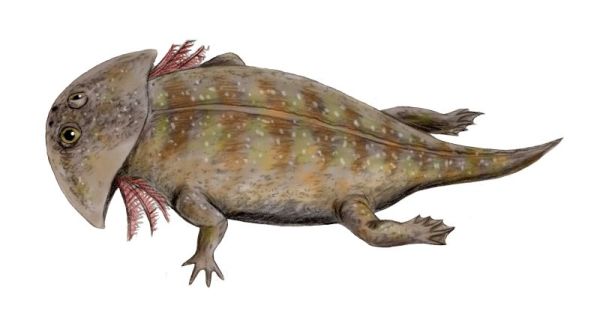
Gerrothorax pulcherrimus, life reconstruction
by Nobu Tamura (Wikipedia)
| Temnospondyli | ||
| The Vertebrates | Plagiosauroidea |
| Vertebrates Home | Vertebrate | Vertebrate |
|
Abbreviated Dendrogram
Tetrapoda
├─┬─Lepospondyli
│ └─Reptiliomorpha
│
└─Temnospondyli
├─Edopoidea
└─┬─Dvinosauria
└─┬─Euskelia
│ ╞═Dissorophoidea
│ │ └─Lissamphibia
│ └─Eryopoidea
└─Stereospondyli
├─Rhinesuchidae
└─┬─Lydekkerinidae
├─┬─Plagiosauroidea
│ ├─Plagiosauridae
│ │ ├─Plagiosaurinae
│ │ └─Plagiosterninae
│ ├─Laidleria
│ └─┬─Rhytidosteidae
│ └─Brachyopoidea
└─┬─Capitosauria
└─Trematosauria
├─Trematosauroidea
└─Metoposauroidea
|
Contents
Index |
 |
|
Gerrothorax pulcherrimus, life reconstruction by Nobu Tamura (Wikipedia) |
Plagiosaurs are unreasonably difficult beasts to research. Despite the fact that Gerrothorax is one of the world's most-illustrated stem tetrapod, articles on the taxon are not easy to find. I am very grateful to Prof. Anne Warren of La Trobe University who has recently (too recently to be used in this version of this Note) supplied me with copies of many of the key articles in the field.
This note will largely consist of a question without even speculative answers. For example, Laidleria, the sister of the Plagiosauridae, has an almost flat, sharply triangular skull, with relatively close-set, dorsal eyes. The plagiosaurs are much bigger, a bit thicker, but generally adhere to the same plan. We are frequently told that this betokens a bottom - dwelling ambush predator like a ray. But rays have a unique ambush style which is completely different from anything a temnospondyl could manage.
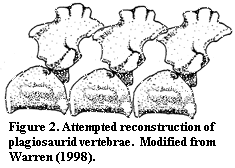
Granted, lifting the flat head off the bottom quickly could generate the same kind of suction that assists the ray, but the plagiosaur has no obvious means of managing that trick against the considerable resistance of the water column. The neural spines of plagiosaurs are strong, but low -- not the sort of arrangement one might associate with strong muscles and powerful tendons which could rapidly raise the head. further, the vertebral column (to extrapolate from Warren (1985) and Warren (1998)) seems designed to inhibit arching of the back. Figure 2 is not to be taken too seriously, but represents an attempt to reconstruct the vertebral articulations, based on Laidleria.
Suppose this obstacle is overcome in some way, then is the plagiosaur to leap lithely forward at the wildly gyrating prey and snap its jaws over the struggling victim? But the plagiosaurs had doubled occipital condyles. These were combined, to be sure, with a relatively advanced atlas-axis complex. Still, quick turns to the side were no easy matter for plagiosaurs. To make matters worse, many plagiosaurs were fairly heavily armored, making quick dashes more difficult.
Likewise, a quick snap of the jaws seems impractical. The very flatness of the head leaves little room for large jaw adductors, as the small (or even absent) adductor chambers (post- or sub- temporal fenestrae) demonstrate. Nor are there tabular horns which might signal a posterior extension of the adductors. In any case, there is almost no conceivable place one could put the adductors which would give them a reasonable mechanical advantage in a flat head.
So how did creatures like plagiosaurs, Diplocaulus or, for that matter, galeaspids, manage to get by? It is hard to imagine an entirely obsolete ecological guild, but it is notable that there are no vertebrates today with wide, flat, relatively inflexible and immobile skulls, dorsal orbits, and terminal or subterminal mouths. Yet this was a fairly common design in Paleozoic times. We may well be dealing with a way of life that has no easy parallels in today's world.
ATW010422.
Trematosauria::: (Rhytidosteidae + Brachyopoidea) + *: Plagiosauridae + Laidleria.
Very short, wide skull with pustular ornamentation; orbits closely spaced and dorsal; pterygoid denticles absent; orbits near midline; $ frontal participates in orbit; quadratojugal dorsal to quadrate and overhangs quadrate; subtemporal fenestra reduced or absent; $ otic notch absent; tabular horns absent; neural spines with lateral buttresses; neural spines relatively short; $ pleurocentra extremely reduced or perhaps absent; $ tessellated & ornamented dorsal osteoderms; some (juvenile forms?) with external gills.
These strange aquatic forms had a very short, wide skull with pustular ornamentation, and upwardly facing eyes in the middle of the head. Many forms had external gills, indicating a return to a fully aquatic environment. So specialized and distinct are they that have often been placed in their own suborder.
MAK010417.
For image, see Laidleria.
Plagiosauroidea Mikko's Phylogeny).
Warren 1998); Yates & Warren (2000).
ATW010725.
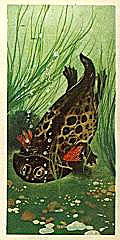 |
Gerrothorax, approx 100cm. |
Gerrothorax, Plagiosternum, Plagiosaurus, Plagioscutum, Plagiobatrachus.
Early Triassic of Australia; Middle Triassic of Germany, and Kazakhstan; Late Triassic of Germany and France, Sweden, Spitzberg, Greenland, and Thailand
Body short & broad; skull flattened ventrally, broad, short and parabolic; maxilla has some, but reduced, participation in choana; dentition with simple infolding of dentine; teeth on medial margin of choana; 4-6 palatine teeth; usually a row of larger, marginal teeth with inner row of smaller teeth & no tusks; width of interpterygoid vacuity pair more than 90% of length; lateral margin of pterygoid on subtemporal vacuity (adductor chamber?) straight in ventral view; subtemporal fenestra reduced or absent; nares closely spaced; orbits anterior to mid-length of skull; lacrimal present; nasal participates in orbital margin; prefrontal absent (?); pineal foramen anterior to center of radiation of parietal; postparietal pair large and more than 4 times wider than long; exoccipital - pterygoid suture present and visible in ventral view; ascending process of pterygoid absent; pterygoid articulates with parasphenoid & exoccipital; "palatal ramus of entopterygoid" = pterygoid?) does not reach vomer; well-developed osseous bar formed by parotic processes of tabular & exoccipital; otic notch reduced or absent; stapes massive; occipital condyles strongly projecting; braincase and gill arches have relatively high degree of ossification; ceratobranchials ossified; possible external gills in adults; gill rakers (!?); atlas highly elongated; vertebrae platycoelous, with equally developed anterior and posterior parapophyses; adjacent vertebral (inter)centra "share" neural arches, so that each centrum has two arches; centra elongate & solid; hemal arches reduced or absent; ribs articulate with 2 consecutive arches (Gerrothorax); normal temnospondyl posterior extension of interclavicle absent; cleithrum very elaborate with 3 lamina, almost completely ornamented on exterior face; dermal armor including equivalent of ossified ventral ribs present (Gerrothorax); ornamentation reticulate or of regularly spaced pustules; frequently found with scutes and complex armor, sometimes ornamented.
ATW
These specialised short-headed amphibians were probably bottom-living suction gulpers, adapted to a totally aquatic existence, as indicated by the presence of gills. They reach a maximum of 2.5 meters, although most were under a meter in length. Plagiosaurus and Gerrothorax were medium-large (around a meter long) of the clade Plagiosauria that lived alongside Cyclotosaurs and phytosaurs. They are best known from the Ladinian to Rhaetian of Europe, but have also been found in Greenland, Spitzberg, the Huai Hin Lat Formation Norian) of Thailand, and the Arcadia Formation (Olenekian - Early Triassic) of Australia (Plagiobatrachus australis [Warren 1985]). The latter is the only record of the family from Gondwana. Plagiosaurs have been found in association with Mastodonsaurs, Capitosaurs, and Metoposaurs, but - except for the Australian record - never with Brachyopids. It can be assumed that the two groups required the same ecological niche, and hence would outcompete each other.
MAK020305
The relationship with Laidleria is not completely secure.
In temnospondyls, the intercentrum dominates over the pleurocentrum. In most other tetrapods, the reverse is true. In fact, the intercentrum disappears in amniotes. I assume that the presence of two pairs of parapophyses is related to this condition.
ATW010804
sh: Prehistoric Animals; Plagiosauroidea; Gerrothorax Printout- Enchanted Learning Software; gerrothorax Swedish?); Paléontologie, licence, chapitre 7; Dinosaurios, Tutorial interactivo; amph.htm.
Milner 1994; Nilsson 1946); Warren (1985); Warren 1995); Warren (1998); Warren & Davey (1992); Warren & Marsicano (2000); Yates & Warren (2000).
ATW020902.
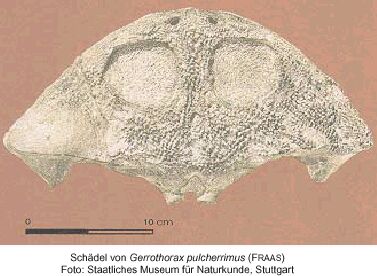 |
|
Gerrothorax pulcherrimus, from the Stubenstein (Middle Norian) of Stuttgart, SW Germany; Fleming Fjord Formation of Greenland illustration from the Staatliches Museum für Naturkunde |
Gerrothorax, Plagiosaurus
Pustulate dermal ornament
These were the common plagiosaurs of the late Triassic of Europe. They flourished right up until the end of the Triassic
Some representative species follow below.
MAK020305
Plagiosaurus depressus
Late Norian Knollenmergel of Halberstadt, Germany
Skull measures 35 cm wide
MAK020305
Gerrothorax pulcherrimus
Middle Norian Stubenstein of Stuttgart, SW Germany; Middle Norian Fleming Fjord Formation of Greenland
Skull measures 30 cm wide
MAK020305
 |
Laidleria gracilis - life reconstruction by Dmitry Bogdanov, Wikipedia |
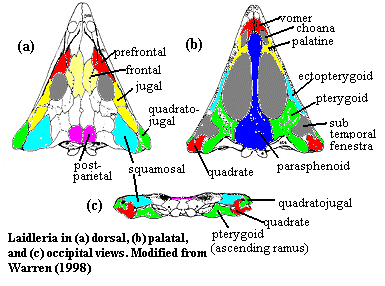
L. gracilis Kitching, 1957
Early Triassic of South Africa.
30-40 cm long. Extremely thin, flat skull forming an equilateral triangle; dentary teeth larger than corresponding maxillary teeth; dentary tusks present; maxilla excluded from choana by sutural articulation of palatine & vomer; more than 8 palatine teeth; no denticles on parasphenoid; ventral surface of pterygoid ornamented; ascending ramus of pterygoid does not contact squamosal; prefrontal and jugal in sutural contact; orbits behind mid-length of skull; quadratojugal with lateral projection; stapes robust, terminating under a solid section of skull roof, with no possible contact with a tympanum; uniform ornamentation of pits surrounded by ridges; strongly armored and "turtle-like;" no specialized scutes associated with neural spines.
Yates and Warren 2000 make this genus the sister clade to the plagiosaurs, whereas Ruta et al 2007 place it on the Rhytidosteidae-Brachyopoid group (Rhytidostea).
Uruyiella liminea Piñeiro et al., 2007 from the Permo-Triassic Buena Vista Formation of Uruguay is a closely related form (Piñeiro et al 2007)
MAK111114
Plagiosauroidea, Wikipedia - Laidleria (stub) , Wikipedia - Uruyiella (stub) .
ATW010421.
checked ATW050530, revised MAK111114